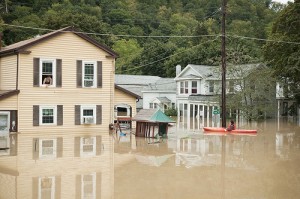 If you have a serious flood, hurricane or other related event in your area, you might be faced with having to do remediation on your own home, or that of a neighbor, friend or family member. Or, you just might do what the DH and I did yesterday; we traveled to a nearby village that was devastated last month with a horrific flood as volunteer members of a team doing demolition on a home owned by a very elderly couple. The entire village was consumed, basically and they are still digging out and cleaning up. A lot of history has gone down the river with that flood and many homes (many of which are very very old) are still not dug out and cleaned up.
If you have a serious flood, hurricane or other related event in your area, you might be faced with having to do remediation on your own home, or that of a neighbor, friend or family member. Or, you just might do what the DH and I did yesterday; we traveled to a nearby village that was devastated last month with a horrific flood as volunteer members of a team doing demolition on a home owned by a very elderly couple. The entire village was consumed, basically and they are still digging out and cleaning up. A lot of history has gone down the river with that flood and many homes (many of which are very very old) are still not dug out and cleaned up.
IMHO, flooding is worse than having a fire. Seriously. With a fire, everything is consumed and once you have cleaned up, you can build fresh and clean. There are no worries about black mold or other horrors hidden in trapped spaces. A little water in a basement can be taken care of with dehumidifiers and a pump. As you can see from the picture above (and let’s not forget New Orleans and Katrina, where people were trapped in their attics up to their necks in water and could only get rescue using axes to cut their way out to the roofs), this water is up to the first floor windows. That means that the basements are flooded to the joists; the first floors are saturated to the window sills. Anything from the floors up to the windows is completely soaked – and that includes any form of insulation in the walls, which will act as a wick to other parts of the walls.
So, even if the water only came to the windows in that photo, the people doing the wreck out in that building will have to demolish everything down to the studs from the floors to the ceiling joists. And they will probably have to take out the floors down to the floor joists as well. And open it all to the air and dehumidifiers, disinfectants and bleach to kill mold and bacteria which will certainly be there and will begin to multiply even before the water leaves.
Now, I have to admit that we had never done this before but we felt that as one of the lucky families in this area, we owed something back to the rest of the community to put in some time. Also, as people who have done demolition (albeit in our own home and not under any sort of horrific conditions), we felt that we could hold our own. Having gone through the experience, I’d like to offer some ideas and a check list for anyone who might be organizing this for a local organization, especially if you have not faced this before:
First and foremost: Do you have a specific home or neighborhood that you are focused on? Has anyone official and trained gone through all the homes and buildings in the neighborhood and done an assessment (it might be FEMA or the local emergency management people)? If so, are reports available for your use? It really is better to know, in a technical way, what you will be facing, literally from the ground up. If you will be working with really old buildings or homes (historic register or not), you will probably be facing laid up stone foundations and dirt floors and crawl spaces. After a flood, these will be slick, muddy and dangerous. If the building or neighborhood still has no power, you will need to bring in generators and work lights; otherwise, people will slip and fall. We won’t even discuss the breathing atmosphere in these areas. But again, having official assessments available will help you tell volunteers what sorts of conditions they will be expected to work under so that they dress properly – this literally may mean rubber boots and battery powered head lamps plus masks or respirators.
Second: What sorts of activities will the team be doing? If the building is still in the pumping out stage, then all the team can do is carry out anything that is not nailed down, pump out, and mop up. These require certain levels of experience such as knowing how to operate gas-powered generators and pumps but will not require anything esoteric in terms of tools. People will need battery powered headlamps, head coverings, eye protection, masks, rubber boots and gloves. If you are past the pumping out stage and are into the removal and demolition stage, things will get more complicated. Basements may need to be emptied of wet insulation, water softeners, furnaces. If this is in the country, there will probably be a fuel tank in the basement as well which might be in poor condition. You may need to contact the local home fuel company to pump this out so that that tank can be removed safely. We worked in a very old home and that basement was the scariest place I’ve ever been – filled with sticky wet mud, dripping insulation and Stygian darkness. You could see your breath down there. When the rest of the team started to do demolition upstairs and things started to fall from the ceiling, we gave up and went to work upstairs.
Upstairs, we faced some pretty interesting structural stuff – all sorts of different insulation products had, over the 100+ years, been used – something that appeared to be like cotton – which I think was kapok – had been stuffed into walls, along with some sort of blown in cellulose insulation. Plus, there were pink fiber glass batts all over the place. One of the things we came up against was that there were radiators under the windows, behind which were architectural wooden panels. No one had removed the radiators, so getting to the panels was difficult, but after we’d seen the sodden mess between the studs in the walls up to about 5′ in the room, we knew that behind those panels was more of the same. By taking out the casings, we were able to get to the panels and remove them, using hands and rakes to take out the wet insulation so that the wood could air and dry.
Third: Volunteers need to know to bring tools and equipment with them. One of the upsetting things about this was that volunteers had been told that there would be tools. The home owners had a single bucket with a couple of hammers and screw drivers. The DH and I had brought along wrecking bars (aka ‘crow bars’) and other tools and another volunteer literally brought everything from a ladder to a ‘saws-all’ with him. Luckily, the home owner had a generator so that we could run lights and the saws.
Fourth: There needs to be an organized work plan available. Another upsetting thing was that the team (which included a bunch of volunteer college students) had been dropped off at the home with no organized activity and no designated crew chief. Eventually, experience and willingness to give orders settled things out but it would have been much more efficient if someone with experience had been designated crew chief, that the ‘adult’ volunteers had been given a more realistic set of instructions and lists of necessary tools. If we’d thought about it and there had been more tools available, we could have trained the kids a bit in terms of doing demolition (they were great kids but had no experience) and I think a lot more could have gotten accomplished in that one day.
Fifth: Have a set up for washing up. When volunteers are going to be at a home clean up all day long, they are going to be, at some point of the day, eating and drinking. Just having bleach wipes is really almost worthless since no one is going to use one of those on their faces and even after you remove safety glasses and masks, there is dust and debris on your face and in your hair. The DH and I brought along two gallons of water, soap and paper towels and cleaned up twice – once for lunch and afterwards before we left. We did not use even a gallon of water but it was certainly helpful in terms of eating the pizza that had been provided with clean hands and faces.
Did we get the job done yesterday? No. We did not. There were about 12 of us (6 adults and 6 college kids) but we could have used another three trained adults with tools. I also think that because there was no work plan, although we did get about 80% of the work on the first floor done, we did not perform the job in the proper order. It really was more important to deal with the basement first (all that moisture is trapped down there and will give trouble on the first floor if it is not dealt with very quickly since winter is coming) and the DH and I along with our college student helper, were only able to get about a third of the wet insulation out of there before we had to abandon the cellar. And of course we did not touch the furnace, the water softener and nothing had been done about the fuel oil tank. This family STILL has a home that is basically unlivable and needs a lot more demolition and clean up before anyone can even start to put it back together again.
And the worst part is that in another month, it will be winter.
(Owego flood photo courtesy of Simon Hucko)
